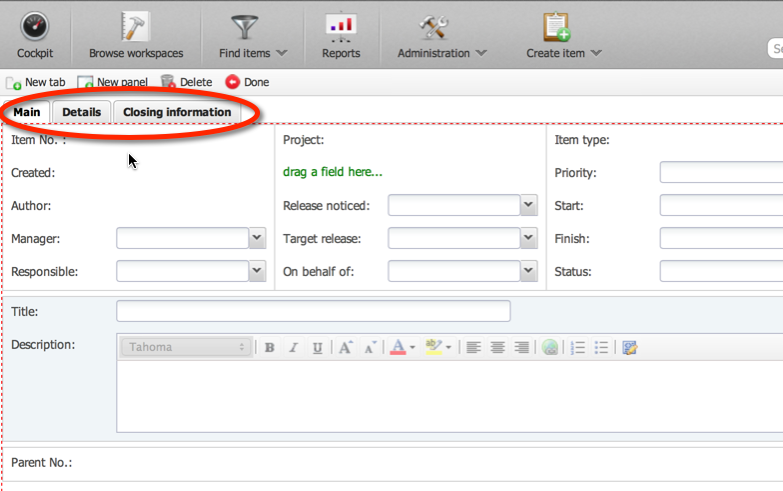Input Forms#
In Allegra, you can define any number of input forms used for creating items, editing items, changing the item status, adding comments to items, and moving items to other projects or item types.
Forms contain fields that represent system attributes and user-defined attributes. If an attribute appears on a form, it is a field there. Forms are associated with the above-mentioned actions, such as creating items. These assignments can be configured
globally
item type-specific
project type and item type-specific
project and item type-specific
This approach supports configuration efficiency while maintaining flexibility.

Each form consists of
tabs
panels
fields
The procedure for creating and using a new form is
Create the new form with the interactive form designer
Assign this form to the desired action, either globally or at a more specific level.
You can change forms at any time.
Tabs#
Each form consists of at least one tab. Tabs contain panels and panels contain fields. The figure shows a form with three tabs. The first tab can be designed as desired. The other two tabs were automatically added to this form because the corresponding function (observer lists and billing) was activated for this project. These tabs are predefined by the system and cannot be interactively changed.

The number of user-defined tabs you can add to your form is only limited in practice. You can freely determine the labeling of the tab.
Panels#
Tabs contain panels. All fields are placed on panels. A panel consists of rows and columns. A panel organizes the space for fields in a grid.

Unused grid positions are specially marked in the form designer and left empty in the rendered form.
There is only a practical limit to the number of panels you can use. You can move windows at any time by drag & drop.
Actions#
In Allegra, forms are associated with actions. For example, you can keep the form for creating an item as simple as possible, while when editing an item all available properties of the item should be displayed. Adding a comment should only include a comment description field and nothing else. Changing a status often goes along with a change of the responsible person, so a comment field, the status field, and the responsible field are needed for this action.
Allegra knows the following actions:
Create item
Edit or change item
Move item to new project or item type
Add comment to item
Change item status
Add subordinate item to existing item
Each of these actions can be assigned a specific form.
